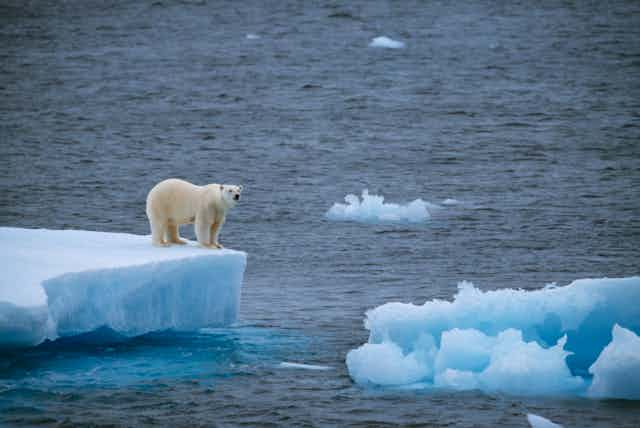Polar bears were once the icon of global warming. Twenty years ago scientists raised the possibility that a world without Arctic sea ice would be a world without polar bears. Last year’s record polar melt suggests that such a future is indeed becoming a reality.
But while debate rages over what to do about shipping routes and mineral resources in an ice-free Arctic, polar bears have become a battle ground for countries, oil companies, conservationists and indigenous people.
Shrinking future
Back in the 1950s there were thought to be only around 5,000 polar bears in the Arctic. Then in 1960 the 19 million acre Arctic National Wildlife Refuge was established, a crucial decision for polar bear protection. Now, thanks to conservation efforts like these, there are 20,000-25,000 polar bears living in 19 different populations on and around the Arctic Ocean.
While today it appears their overall population status is not of grave concern, there is also little doubt that polar bears have become increasingly endangered in recent decades. Under the IUCN the bears are now listed as Vulnerable. Indeed, eight populations are now declining, reputedly due to increasing economic development coupled with global warming.
Polar bears have a unique dependence on sea ice because that is where they find most of their prey. As sea ice shrinks, the ringed and bearded seals that provide most of the food for bears, have become much harder to catch.
Several studies have demonstrated a loss of some million square kilometres of sea ice over the last 25 years, inevitably reducing the resilience of polar bear populations.
Bears and oil don’t mix
Increasing interest in polar resources has brought bears into conflict with people. Multinational oil and gas companies regard polar conservation as a constraint on their business activities, and they actively contest the need for bear protection.
In 2008, in response to these increased pressures, the US government declared the species as Threatened under the Endangered Species Act. Although this does give individual states (such as Alaska) the authority to protect the species, and to take action against those who negatively impact upon it, it does not come under federal legislation.

Along the coast of the Beaufort Sea, considered the core of the fragile ecology in that part of the Arctic, political and economic lobbying to allow drilling is putting pressure on decision makers. This came to a head in early 2013 when a group of multinationals put up a legal challenge to the listing of polar bears as threatened, in the hope of reducing the restrictions on the expansion of their operations.
The US Court of Appeal ruled that the protection of polar bears under the Endangered Species Act was justified, and should continue. Thanks to this decision, threats from multinational oil and gas interests will be moderated for now, giving polar bears more chance of survival into the future.
Going on a bear hunt
Polar bears were under consideration for listing under Appendix II of Convention on International Trade in Endangered Species (CITES) which would have banned all trade in polar bear products.
Somewhat surprisingly, in March 2013 this proposal was rejected out of consideration for indigenous livelihoods. Inuit Canadians and other polar people trade in polar bear pelts, paws and fangs, creating income of over $2 million a year.

While recognising the concerns of indigenous people, the 2013 CITES meeting ruled that the decline of the polar bear population had not yet reached a “threshold of concern”. This is the level of species decline at which experts intervene to declare a species in need of special protection. For polar bears, this is defined as a rate of decline of 50% over a 45 year period.
According to the IUCN, since the 1970s, polar bears have declined by 30%. This means that although conditions are rapidly changing in the Arctic, the recorded changes in bear populations have not yet reached the level of concern which would justify CITES intervention.
Thresholds of concern
This complexity of human-ecological interaction shows the need for conservation of polar bears to be holistic and interdisciplinary. Only by taking such an approach can a balanced and sustainable solution to Arctic management be achieved. A start would be to consider lowering the threshold of concern used by CITES to support their decisions.
Australia has also been supporting bear conservation, through captive breeding, and has recently celebrated the birth of a baby polar bear, the second Australia has contributed to the international gene pool. This is an excellent demonstration of how countries can play a role in global conservation issues, even if they are far removed from the problem itself.


